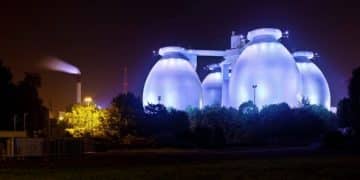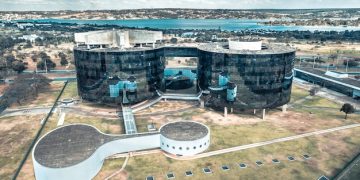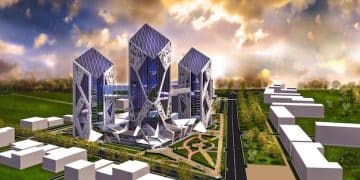Are Small Modular Reactors the Answer to US Energy Needs by 2027?
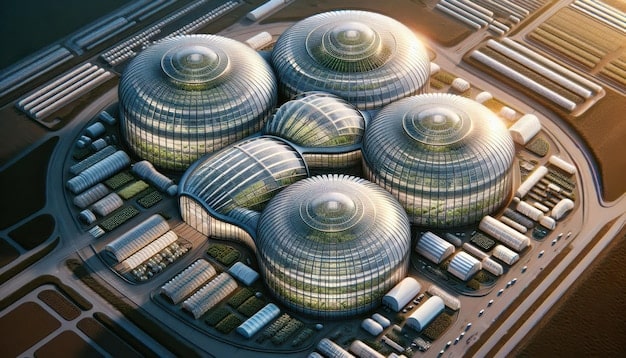
Small Modular Reactors (SMRs) present a promising, albeit challenging, pathway to diversifying and decarbonizing the U.S. energy portfolio by 2027, offering enhanced safety features, reduced capital costs, and flexible deployment options compared to traditional nuclear power plants.
The pressing need for clean and reliable energy sources has spurred a global interest in innovative nuclear technologies. Among these, Small Modular Reactors (SMRs) a Viable Solution for US Energy Needs by 2027? are gaining traction as a potential game-changer in the US energy landscape.
Understanding Small Modular Reactors (SMRs)
Small Modular Reactors (SMRs) represent a paradigm shift in nuclear power generation. Unlike conventional large-scale nuclear plants, SMRs are smaller, more flexible, and designed for factory production and on-site assembly. This modularity offers several advantages, including reduced capital costs and shorter construction timelines.
Key Characteristics of SMRs
SMRs typically have a generating capacity of up to 300 MW(e) per unit, which is about one-third the size of traditional nuclear reactors. Their compact design allows for deployment in various locations, including remote areas and industrial sites.
Enhanced Safety Features
SMRs incorporate passive safety systems that rely on natural forces such as gravity and convection to shut down the reactor in emergency situations, reducing the risk of accidents.
- Modularity: Factory fabrication reduces construction time and costs.
- Scalability: Allows for incremental capacity additions based on demand.
- Safety: Passive safety systems enhance reliability.
- Versatility: Suitable for diverse applications, including electricity generation, heating, and desalination.
In summary, SMRs offer a compelling alternative to conventional nuclear power, with the potential to play a significant role in meeting future energy demands while minimizing environmental impact.
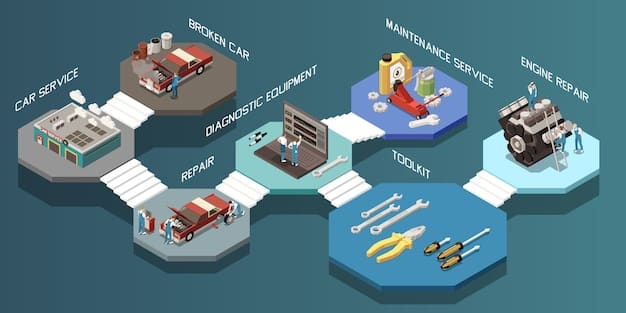
The US Energy Landscape and the Role of Nuclear Power
The United States faces a complex energy challenge, balancing the need for reliable power with the imperative to reduce carbon emissions. Nuclear power currently accounts for about 20% of the nation’s electricity generation, providing a significant source of carbon-free energy.
Current Energy Mix
The US energy mix is diverse, comprising natural gas, coal, nuclear, and renewables. However, the reliance on fossil fuels contributes to greenhouse gas emissions and climate change.
The Need for Clean Energy
To meet its climate goals, the US must transition to cleaner energy sources. Nuclear power, with its zero-carbon emissions during operation, can play a crucial role in this transition.
Nuclear energy provides around-the-clock power, unlike solar and wind, which are intermittent and depend on weather conditions.
Challenges for Nuclear Power
Despite its benefits, nuclear power faces challenges, including high upfront costs, regulatory hurdles, and public perception concerns.
In conclusion, nuclear power is a vital component of the US energy landscape, and its potential can be further unlocked through innovative technologies like SMRs but this requires addressing some hurdles.
Economic Viability of SMRs in the US by 2027
The economic viability of Small Modular Reactors (SMRs) in the US by 2027 hinges on several factors, including capital costs, operating expenses, and market competitiveness.
Capital Costs
One of the primary advantages of SMRs is their potential for lower capital costs compared to traditional large-scale nuclear plants. Factory fabrication and modular construction can lead to economies of scale and reduced construction timelines.
Operating Expenses
SMRs are designed to be more efficient and require less on-site staff, which can lower operating expenses. Additionally, their enhanced safety features can reduce insurance costs.
- Government Incentives: Tax credits, grants, and loan guarantees can improve the economic attractiveness of SMR projects.
- Private Investment: Attracting private capital is essential for the successful deployment of SMRs.
- Levelized Cost of Energy (LCOE): SMRs must be competitive with other energy sources in terms of LCOE to gain market share.
Regulatory Framework
A streamlined and predictable regulatory framework is crucial for the economic viability of SMRs. The Nuclear Regulatory Commission (NRC) is working to develop a clear licensing process for SMRs.
Summarily, the economic viability of SMRs in the US by 2027 depends on reducing capital costs, optimizing operating expenses, and establishing a supportive regulatory environment.

Technological Readiness and Deployment Timelines
The technological readiness of Small Modular Reactors (SMRs) is a critical factor in determining their viability by 2027. Several companies are developing SMR technologies, with some projects nearing completion.
Current SMR Projects
NuScale Power is the only company to have received design approval from the NRC for its SMR technology. Other companies, such as GE Hitachi and TerraPower, are also actively developing SMR designs.
Deployment Challenges
Despite the progress, deploying SMRs by 2027 faces challenges, including supply chain constraints, workforce development, and regulatory approvals.
Timelines for construction and licensing can vary depending on the specific design and location.
Potential for Hybrid Energy Systems
SMRs can be integrated with renewable energy sources to create hybrid energy systems that provide reliable and clean power.
They can also support other applications, such as hydrogen production and district heating.
To conclude, the technological readiness of SMRs is advancing, but deployment timelines must be accelerated to achieve viability by 2027.
Regulatory and Policy Considerations for SMRs
The regulatory and policy landscape plays a significant role in the deployment of Small Modular Reactors (SMRs) in the US. A clear and supportive regulatory framework is essential for attracting investment and ensuring public safety.
Nuclear Regulatory Commission (NRC)
The NRC is responsible for licensing and regulating nuclear power plants in the US. The agency is working to adapt its regulations to the unique characteristics of SMRs.
Licensing Process
The licensing process for SMRs involves several stages, including design certification, construction permit, and operating license. Streamlining this process is crucial for reducing deployment timelines.
- Stakeholder Engagement: Engaging with local communities, environmental groups, and other stakeholders can help address concerns and build support for SMR projects.
- Public Acceptance: Public perception of nuclear power is a key factor in the successful deployment of SMRs.
- Government Support: Continued government funding for research and development and deployment incentives can accelerate the adoption of SMRs.
Community Engagement
Effective communication and transparency are essential for building trust and addressing concerns related to nuclear power.
Simply put, a supportive regulatory and policy environment is essential for the successful deployment of SMRs in the US.
Environmental Impact and Sustainability of SMRs
Small Modular Reactors (SMRs) offer several environmental advantages over traditional fossil fuel-based power plants. They produce zero-carbon emissions during operation, contributing to cleaner air and reduced greenhouse gas emissions.
Waste Management
Nuclear waste management remains a challenge for the nuclear industry. However, SMRs can be designed to produce less waste and utilize advanced fuel cycles that reduce the volume and radioactivity of waste.
Water Usage
SMRs can be designed to use less water than traditional nuclear plants, which is particularly important in arid regions. Air-cooled SMR designs can further reduce water consumption.
SMRs can be located closer to population centers, reducing transmission losses and improving grid resilience.
Land Use
When compared to other energy sources such as wind or solar, nuclear plants require less land to generate the same amount of energy.
In conclusion, SMRs offer significant environmental benefits, contributing to cleaner air, reduced greenhouse gas emissions, and more sustainable energy production.
| Key Point | Brief Description |
|---|---|
| 💡SMR Advantages | Smaller, safer, and more scalable than traditional nuclear. |
| 🎯 Key to 2027? | Viability depends on cost reduction and regulatory streamlining. |
| 🌍 Environmental Impact | Zero-carbon emissions during operation, supports sustainability. |
| 🏛️ Regulatory Hurdles | NRC licensing and policy frameworks need to be more adaptive. |
Frequently Asked Questions (FAQ)
▼
SMRs offer enhanced safety features, reduced capital costs due to modular construction, and greater flexibility in siting compared to traditional nuclear reactors. They can also be integrated with renewable energy sources.
▼
SMRs produce zero-carbon emissions during operation, helping to reduce greenhouse gas emissions and combat climate change. They can play a critical role in meeting clean energy targets set by the US government.
▼
Key challenges include securing regulatory approvals, reducing capital costs, addressing supply chain constraints, and ensuring public acceptance. Technological readiness and workforce development are also important factors.
▼
The Nuclear Regulatory Commission (NRC) is responsible for licensing and regulating nuclear power plants in the US. The NRC is adapting its regulations to the unique characteristics of SMRs to ensure safety and security.
▼
SMRs offer significant environmental benefits, including zero-carbon emissions during operation and reduced water usage compared to traditional nuclear plants. They can also be designed to produce less nuclear waste.
Conclusion
In conclusion, while Small Modular Reactors hold significant promise for transforming the US energy sector by 2027, their viability hinges on overcoming economic, regulatory, and technological hurdles. With concerted efforts from government, industry, and research institutions, SMRs could indeed play a pivotal role in meeting the nation’s growing energy needs while advancing its clean energy goals.
